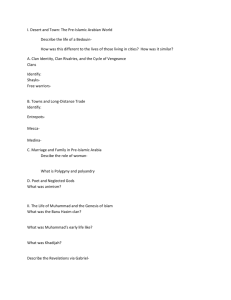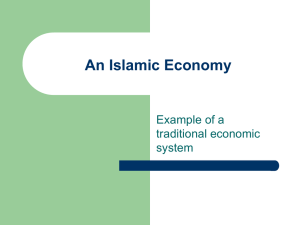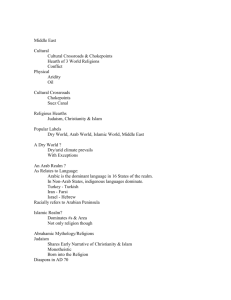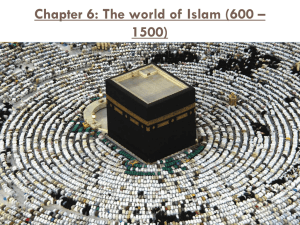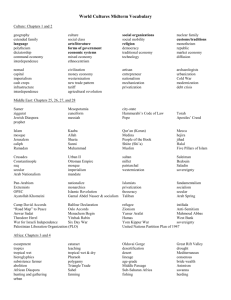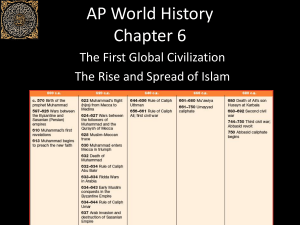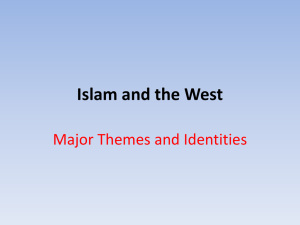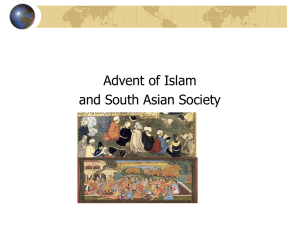Chapter 9 - SharpSchool
advertisement
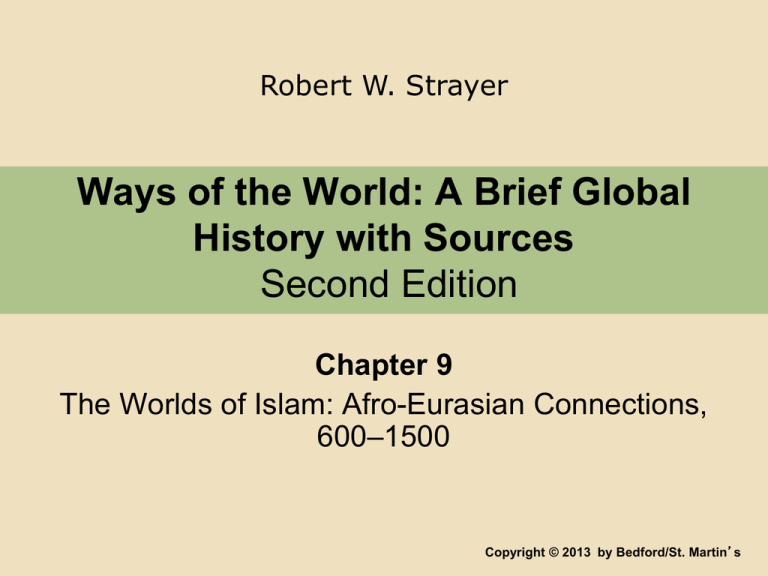
Robert W. Strayer Ways of the World: A Brief Global History with Sources Second Edition Chapter 9 The Worlds of Islam: Afro-Eurasian Connections, 600–1500 Copyright © 2013 by Bedford/St. Martin’s I. The Birth of a New Religion A. The Homeland of Islam 1. Tribal feuds and trading centers of the Arabian Peninsula 2. Mecca: home of the Kaaba and the Quraysh 3. Contact with Byzantine and Sassanid Empires 4. Gods, idols, and “children of Abraham” I. The Birth of a New Religion B. The Messenger and the Message 1. Muhammad Ibn Abdullah (570–632) 2. Series of revelations (610–632) become the Quran 3. Revolutionary message of monotheism 4. A return to the religion of Abraham I. The Birth of a New Religion B. The Messenger and the Message 5. “Seal of the prophets” 6. Revolutionary message of social justice: the Umma 7. Five Pillars of Islam 8. “Greater” and “Lesser” Jihad I. The Birth of a New Religion C. The Transformation of Arabia 1. Tension in Mecca and the Hijra, 622 2. Building the Umma in Medina 3. War, alliances, and entry into Mecca, 630 4. Most of the Peninsula under a unified Islamic state 5. Fusion of religious and political authority 6. Sharia II. The Making of an Arab Empire A. War, Conquest, and Tolerance 1. From the Iberian Peninsula to the Indus River 2. Battle of Talas, 751 3. Economic drive and spreading the faith 4. Dhimmis and the Jizya II. The Making of an Arab Empire B. Conversion 1. Spiritual versus social conversion 2. Slaves, prisoners of war, and merchants 3. Conversion without Arabization: Persia, Turks, and Pakistan 4. Persian influences on Islamic world II. The Making of an Arab Empire C. Divisions and Controversies 1. First Four Caliphs (632–661) and civil war 2. Sunni versus Shia 3. Umayyad (661–750): Damascus 4. Abbasid (750–1258): Baghdad 5. Post–ninth-century sultanates 6. Interpreting and practicing Sharia 7. Sufi II. The Making of an Arab Empire D. Women and Men in Early Islam 1. Women in the Quran, Hadith, and Sharia 2. Restrictions for elite women in the golden age III. Islam and Cultural Encounter: A Four-Way Comparison A. The Case of India 1. Turkic invaders 2. Disillusioned Buddhists and lower-caste Hindus 3. Appeal of Sufi mystics 4. Punjab, Sind, and Bengal 5. Sikhism III. Islam and Cultural Encounter: A Four-Way Comparison B. The Case of Anatolia 1. Turkic invaders 2. 90 percent by 1500 3. Ottoman Empire III. Islam and Cultural Encounter: A Four-Way Comparison C. The Case of West Africa 1. Muslim merchants and scholars 2. Urban centers 3. Little penetration of rural world and popular culture III. Islam and Cultural Encounter: A Four-Way Comparison D. The Case of Spain 1. Arab and Berber invasion of Al-Andalus 2. Cordoba’s golden age 3. Increased intolerance 4. Christian reconquest and expulsion IV. The World of Islam as a New Civilization A. Networks of Faith 1. Ulamas and Madrassas 2. Sufi shaykhs and poets 3. The hadj IV. The World of Islam as a New Civilization B. Networks of Exchange 1. Vast hemispheric trading zone 2. Merchants and urban elites 3. Technological exchange and an Islamic “Green Revolution” 4. Mathematics and medicine V. Reflections: Past and Present: Choosing Our History A. B. C. D. E. “Present-mindedness” Islamic glories and Western encroachment Using an Islamic past Diversity of the Islamic world Histories of Tolerance and Conflict
